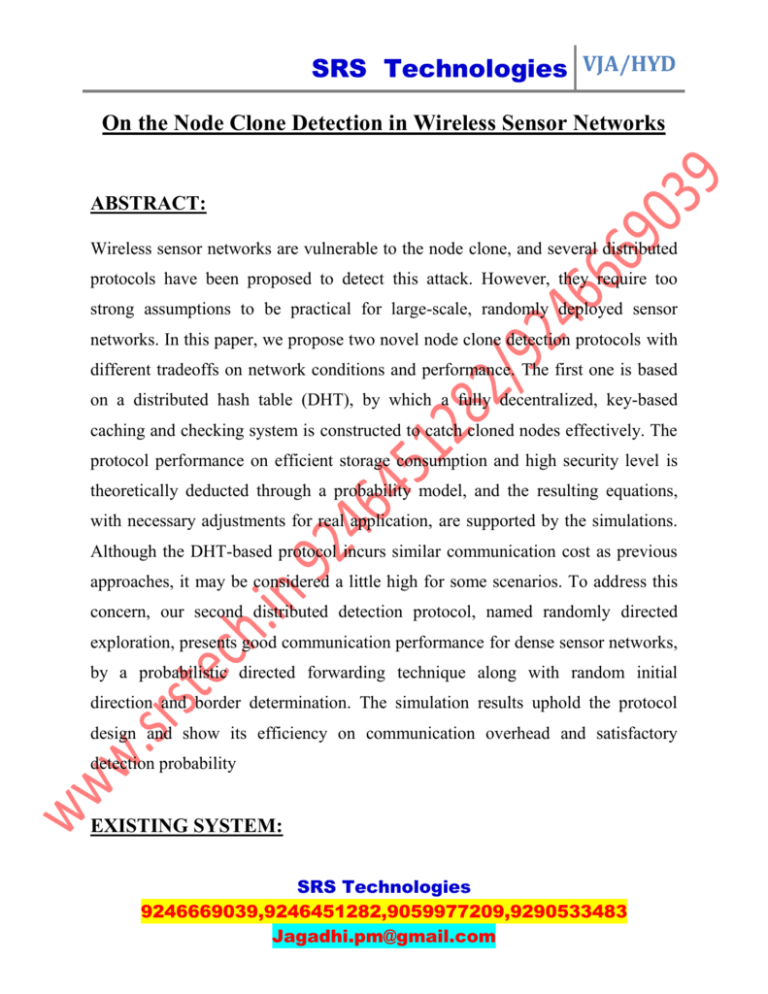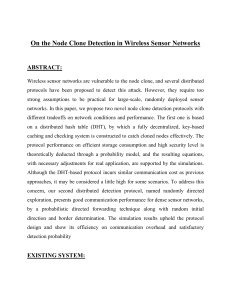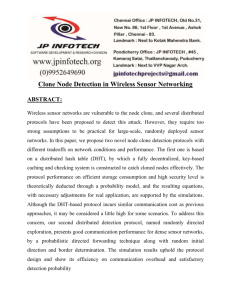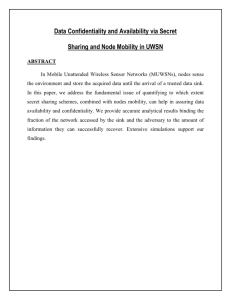randomly detection
advertisement

SRS Technologies VJA/HYD On the Node Clone Detection in Wireless Sensor Networks ABSTRACT: Wireless sensor networks are vulnerable to the node clone, and several distributed protocols have been proposed to detect this attack. However, they require too strong assumptions to be practical for large-scale, randomly deployed sensor networks. In this paper, we propose two novel node clone detection protocols with different tradeoffs on network conditions and performance. The first one is based on a distributed hash table (DHT), by which a fully decentralized, key-based caching and checking system is constructed to catch cloned nodes effectively. The protocol performance on efficient storage consumption and high security level is theoretically deducted through a probability model, and the resulting equations, with necessary adjustments for real application, are supported by the simulations. Although the DHT-based protocol incurs similar communication cost as previous approaches, it may be considered a little high for some scenarios. To address this concern, our second distributed detection protocol, named randomly directed exploration, presents good communication performance for dense sensor networks, by a probabilistic directed forwarding technique along with random initial direction and border determination. The simulation results uphold the protocol design and show its efficiency on communication overhead and satisfactory detection probability EXISTING SYSTEM: SRS Technologies 9246669039,9246451282,9059977209,9290533483 Jagadhi.pm@gmail.com SRS Technologies VJA/HYD WIRELESS sensor networks (WSNs) have gained a great deal of attention in the past decade due to their wide range of application areas and formidable design challenges. In general, wireless sensor networks consist of hundreds and thousands of low-cost, resource-constrained, distributed sensor nodes, which usually scatter in the surveillance area randomly, working without attendance. If the operation environment is hostile, security mechanisms against adversaries should be taken into consideration. Among many physical attacks to sensor networks, the node clone is a serious and dangerous one. Because of production expense limitation, sensor nodes are generally short of tamper-resistance hardware components; thus, an adversary can capture a few nodes, extract code and all secret credentials, and use those materials to clone many nodes out of off-the-shelf sensor hardware. Those cloned nodes that seem legitimate can freely join the sensor network and then significantly enlarge the adversary’s capacities to manipulate the network maliciously DISADVANTAGES OF EXISTING SYSTEM: Among many physical attacks to sensor networks, the node clone is a serious and dangerous one. Insufficient storage consumption performance in the existing system and low security level. PROPOSED SYSTEM: SRS Technologies 9246669039,9246451282,9059977209,9290533483 Jagadhi.pm@gmail.com SRS Technologies VJA/HYD In this paper, we present two novel, practical node clone detection protocols with different tradeoffs on network conditions and performance. The first proposal is based on a distributed hash table (DHT) by which a fully decentralized, key-based caching and checking system is constructed to catch cloned nodes. The protocol’s performance on memory consumption and a critical security metric are theoretically deducted through a probability model, and the resulting equations, with necessary adjustment for real application, are supported by the simulations. In accordance with our analysis, the comprehensive simulation results show that the DHT-based protocol can detect node clone with high security level and holds strong resistance against adversary’s attacks. Our second protocol, named randomly directed exploration, is intended to provide highly efficient communication performance with adequate detection probability for dense sensor networks. In the protocol, initially nodes send claiming messages containing a neighbor-list along with a maximum hop limit to randomly selected neighbors; then, the subsequent message transmission is regulated by a probabilistic directed technique to approximately maintain a line property through the network as well as to incur sufficient randomness for better performance on communication and resilience against adversary. In addition, border determination mechanism is employed to further reduce communication payload. During forwarding, intermediate nodes explore claiming messages for node clone detection. By design, this protocol consumes almost minimal memory, and the simulations show that it outperforms all other detection protocols in terms of communication cost, while the detection probability is satisfactory. ADVANTAGES OF PROPOSED SYSTEM: SRS Technologies 9246669039,9246451282,9059977209,9290533483 Jagadhi.pm@gmail.com SRS Technologies VJA/HYD The DHT-based protocol can detect node clone with high security level and holds strong resistance against adversary’s attacks. Randomly directed exploration, is intended to provide highly efficient communication performance with adequate detection probability for dense sensor networks. SYSTEM CONFIGURATION:HARDWARE CONFIGURATION: Processor Speed - Pentium –IV 1.1 Ghz RAM - 256 MB(min) Hard Disk - 20 GB Key Board - Standard Windows Keyboard Mouse - Two or Three Button Mouse Monitor - SVGA SOFTWARE CONFIGURATION:- Operating System : Windows XP SRS Technologies 9246669039,9246451282,9059977209,9290533483 Jagadhi.pm@gmail.com SRS Technologies VJA/HYD Programming Language Java Version : JAVA : JDK 1.6 & above. REFERENCE: Zhijun Li, Member, IEEE, and Guang Gong, Senior Member, IEEE “On the Node Clone Detection in Wireless Sensor Networks”- IEEE/ACM TRANSACTIONS ON NETWORKING, 2013. SRS Technologies 9246669039,9246451282,9059977209,9290533483 Jagadhi.pm@gmail.com









